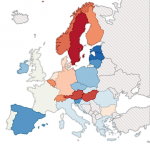This map, based on a asylum in Europe.
The immigrant population increased the most in Sweden, Hungary and Austria, “which each saw an increase of more than 1 percentage point”, reports the Pew findings. This variation might seem small, but the Pew points out that “a 1-point increase in a single year is rare, especially in Western countries”, and reminds that it took “a decade” for the US immigrant share of population “to increase by about one point (from 13 percent to 14 percent in 2005-2015).”
Sweden, Norway and Austria already have “substantial” foreign-born populations, with more than 15 percent of the inhabitants being born abroad, while some countries like Hungary or Finland have a fairly small immigrant population. Here, the surge was particularly significant (plus 1.3 percent increase in Hungary), and triggered hostile reactions from the authorities. Other countries who opposed the European commission refugee quota plan, like Poland, Slovakia and the Czech Republic, saw very little or no increase in their already small immigrant share of the population.
Some countries with large immigrant populations, like France and the United Kingdom, “received far fewer asylum applicants relative to their population size” in the last two years, while Germany “received the most asylum seekers of any other European country”. The increase in the foreign-born population was modest, due to the size of the German population.
“On the other end of the spectrum”, adds the Pew Research Center,
nations including Lithuania, Spain, Slovenia, Estonia and Latvia saw their immigrant shares decrease during this time. This is in part because these countries did not receive a high number of asylum seekers during the past year. In addition, their existing foreign-born population is declining as immigrants return home (as in Latin Americans in Spain) and aging immigrants die (as in Latvia).
The report concludes that –
The size of immigrant populations will likely change as migration into Europe shifts. agreement to divert refugees to Turkey and other EU nations. Nonetheless, asylum seekers continue to enter Europe, most recently with sub-Saharan Africans crossing the Mediterranean Sea and into Italy.
The map below shows the share of the foreign-born population.
Do you like our work?
Help multilingual European journalism to thrive, without ads or paywalls. Your one-off or regular support will keep our newsroom independent. Thank you!
















